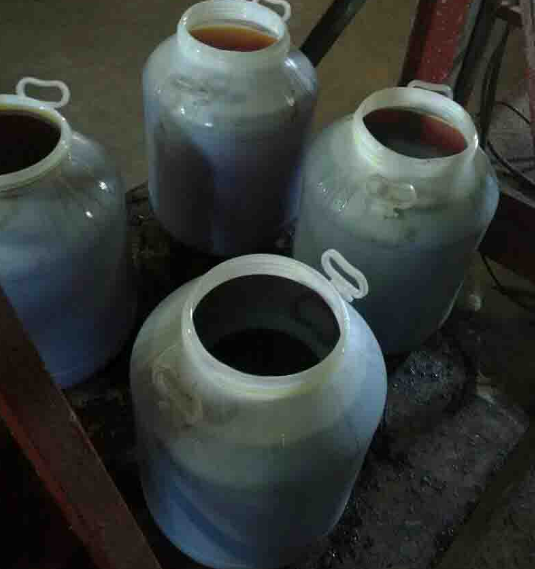Polysorbate 60
Polysorbate 60 is an oil-water emulsifier that can be dissolved in water, ethanol and toluene. It is used as a lubricant and emulsifier in some food and textile industries. We recommend that you use it in combination with it for better results.
Technical Information of Polysorbate 60
Polysorbate 60 is mainly used in the cosmetics, pharmaceutical and food industries. Polyoxyethylene sorbitan monostearate’s main goal is to improve formulas. It is a good stabilizer, emulsifier and surfactant.
Polyoxyethylene sorbitan monostearate
CAS NO.:9005-67-8
MOLECULAR WEIGHT: 1311.65
E NO.:E435
MOLECULAR FORMULA
C64H126026
The molecular formula of polysorbate 60 is C64H126026.
Advantages of Polysorbate 60
Widely applications : in food,cosmetics and pharmaceutical and industry.
polysorbate 60 is an emulsifier, surfactant and stabilizer.
What Is Polysorbate 60?
Polysorbate 60 which is also known as its brand name Tween-60 is a sorbitol-based emulsifier and surfactant. When added to processed foods, it acts as an additive that prevents fats from separating out for the texture and stability of the said food products to improve. It is also found in skincare formulations of top-grade products. It can act as an emulsifier in skincare products that aids for even distribution of its ingredients properly like its antioxidants and whitening capabilities. The addition of polysorbates 60 on these skincare products improve its effectiveness.
If you are asking what is Polyoxyethylene sorbitan monostearate , it can act as a high HLB emulsifier when combined with low HLB emulsifiers. It creates stable oil-in-water emulsions. When added with other emulsifiers like LMG and propylene glycol monoesters, it can be used in production of commercial nondairy whipped products.
Its composition is a polymer composed of PEG-related sorbitan. It contains 20 polyethylene glycol units that improves the texture and sensory feel of various products. With an HLB value of 14.9, Polyoxyethylene sorbitan monostearate is classified as an oil-in-water emulsifier that demonstrates solubility in water, ethanol, ethyl acetate, and toluene.
Polysorbate 60 VS 80
Polysorbate 60 VS 80 : This is a kind of light yellow and amber color at room temperature. It looks like a liquid emulsifier. It is a relatively thick substance.
In terms of performance, it is insoluble in mineral oil and animal oil, but it can be miscible with solvents such as methanol and ethanol. It has good lubricity and emulsifying properties and excellent dispersion properties, which means it is insoluble in mineral oil. .
From an application point of view, its largest application areas are as an additive in food, and as a softener or antistatic agent in the textile industry. In some industries, it is used as an oil in paints. Tanaka is also widely used. In the fields of cosmetics, medicine and other fields, it is used as a dispersant, emulsifier, stabilizer, and wetting agent. In the production of some polyurethane foams, it is used as a foaming auxiliary. In some synthetic fibers, it is used as a Antistatic agent is used, and it can also be widely used in the production of some photographic films and the production of waterproof emulsified silicone oil for some fabrics.
Origin
Polysorbate-60 may be traced back to its original chemical makeup as well as the manufacturing procedure that it went through. Polyoxyethylene (20) sorbitan monostearate, or more often known as polysorbate-60, is a kind of sorbitan ester. This substance is an ethoxylated molecule that can be produced by reacting ethylene oxide, sorbitol, and stearic acid in a chemical reaction.
Stearic acid is a saturated fatty acid. This serves as a crucial component in the production of Polysorbate 60. It is obtained from vegetable oil derivatives such as rapeseed or palm oil. This natural origin is essential as it contributes to the overall safety and suitability of polysorbate 60 in food manufacturing and processing industry.
To create Polysorbate 60, stearic acid is first reacted with sorbitol, resulting in the formation of sorbitan monostearate. Sorbitan monostearate is then subjected to a condensation reaction with ethylene oxide. This process leads to the ethoxylation of sorbitan monostearate which transforms it into Polysorbate 60 in yellow-amber color.
Polysorbate 60 Formula
The Role and Effect of Polysorbates 60
Polysorbate-60 is primarily used for its ability to blend water and oil together effectively. It significantly improves the emulsification and lubricity. Its water solubility makes it an environmentally safe and friendly ingredient. Its ability to blend water and oil, stabilize emulsions, and enhance product texture makes it a valuable ingredient.
Surfactant
As a surfactant, Polysorbate-60 lowers the surface tension of the skin when used in shampoos and body washes. This property allows it to help wash away body dirt and impurities. This promotes effective cleansing and leaving the skin feeling fresh and clean. It can help to effectively lifts away dirt, sweat, and sebum with any other oil-based impurities that have accumulated on the skin or hair. The surfactant forms tiny droplets called micelles that encapsulate the oils and dirt. These allows them to be rinsed away easily with water.
Emulsifier
Emulsifiers are crucial for stabilizing emulsions. This ensures that oil and water do not separate and form distinct layers. Polysorbate prevents fat globules from agglomerating in cosmetic products. This is valuable in creating stable emulsions in creams, lotions, and other products with a combination of oil and water components. This is essential for creating stable and well-blended formulations in various cosmetic products.
Solubilizer
Polysorbate 60 also acts as a solubilizer, allowing certain ingredients that are otherwise not water-soluble to disperse and dissolve in water-based solutions. This solubilizing property enhances the compatibility of various components in cosmetic formulations, leading to better product performance and a smoother texture. It allows the inclusion of beneficial hydrophobic ingredients that contribute to the product’s performance, such as natural plant extracts or essential oils.
What is Polysorbates60 Used For?
What Is Polysorbate 60 In Food?
This is a very popular and popular food additive. It is well absorbed by the body, especially in cakes or cake mixes or ice cream. It is also used as a foaming agent in some alcoholic beverages. It is used as a dispersant in some candies. In short, it is very popular in food applications.
Polyoxyethylene sorbitan monostearate
Polysorbate 60 is a multi-functional compound with diverse applications. Its roles as an emulsifier and solubilizer make it indispensable to ensure stability, uniformity, and improved performance. It can also enhance texture and quality.
Formulating Creams, Gels, Lotions, and Suspensions
Polysorbate-60 helps stabilize the emulsions, ensuring uniform distribution and a smooth texture, enhancing the overall quality and feel of the product. Creams, gels, lotions, and suspensions often contain a combination of water and oil components, which can naturally separate. The addition of polysorbate60 as an emulsifier avoids this.
Usage in Medicine
Polysorbate60 facilitates the dispersion of active pharmaceutical ingredients in liquid formulations to ensure uniform distribution and improved bioavailability. If we improve the solubility of medicines, polysorbate60 can help in the delivery and absorption of medicines for much better therapeutic efficacy.
Food Uses of Emulsifiers
Polysorbate 60 in food products stabilize emulsions when combining water and oil components, such as dressings, sauces, and baked goods. It prevents the separation of fat and water in processed foods and in the following products.
· Dairy Products
· Salad Dressings
· Margarine
· Shortening
· Pasta
· Baked Products
FDA Specifics
The FDA has established specific guidelines for the use of polysorbate 60 in food products. These guidelines outline the maximum allowable amounts of Polysorbate 60 in different food categories to ensure consumer safety and product quality.
Polysorbate 60 can be used as an emulsifier in whipped edible oil toppings. However, the maximum amount of Polysorbate 60 used should not exceed 0.4 percent of the weight of the finished whipped edible oil topping. When used alone, the maximum amount of Polysorbate 60 in cake or cake mix should not exceed 0.46 percent, based on a dry-weight basis.
Polysorbate 60 can be used alone in nonstandardized confectionery coatings or standardized cacao products, but the maximum amount used should not exceed 0.5 percent of the weight of the finished product. The maximum amount of polysorbate60 used should not exceed 0.3 percent of the weight of the finished dressings. Polyoxyethylene sorbitan monostearate can be used to impart greater opacity to sugar-type confection coatings as well but should not exceed 0.2 percent of the weight of the finished sugar coating.
Is Polysorbate 60 Safe?
The quantity of polysorbate 60 that is used in skin care products may significantly affect how safe the ingredient is. investigations have revealed that quantities of 5% or more may cause irritation to the skin; however, other investigations with larger concentrations of up to 15% have not showed an irritating or hypersensitive reaction from the skin. Polysorbate 60 is regarded as being harmless to the skin at concentrations lower than 5%, and a concentration of 1% is regarded as being non-irritating to the skin.
Polysorbate 60 must be used in a manner that complies with all of the FDA’s rules if it is to be used in the food sector. Polysorbate 60 is regarded as being fit for human consumption when it is used in food items within the parameters that have been established by the FDA.
After conducting an investigation, the Expert Panel on Cosmetic Ingredients Review found that Polysorbate 60 is suitable for use in cosmetics and other personal care items without posing any health risks. On the other hand, the fact that this substance contains ethylene oxide has raised some worries regarding its safety. According to the National Toxicology Program, the process of ethoxylation that takes place during the production of Polysorbate 60 has the potential to result in contamination with 1,4-dioxane, which is a substance that has the ability to cause cancer. Polysorbate 60 may be used risk-free in topical skincare products provided that it is utilized in accordance with all applicable rules and at the right doses.
polysorbate 60 in food
Polyoxyethylene sorbitan monostearate Alternatives
In the creation of skincare products, Polysorbate 60 is interchangeable with a wide variety of other substances, depending on the nature of the particular use and the qualities that are sought for. The combination of cetearyl alcohol and cetearyl glucoside may be used in the manufacture of skincare products as an emulsifier. Cetearyl Alcohol is an example of a fatty alcohol that is obtained from natural sources such as coconut or palm oil, while cetearyl glucoside is an example of an emulsifier that is created from sugar.
You may also use natural emulsifiers called Cetearyl Olivate and Sorbitan Olivate, both of which are produced from olive oil. These emulsifiers are natural and efficiently imitate the structure of the lipid layer that is found on the skin. They provide a great compatibility with the skin, which gives moisture for the enhancement of the formulation’s texture in skincare products.
The emulsifying characteristics of Glyceryl Stearate, Sodium Stearoyl Lactylate, and Cetearyl Alcohol are augmented by the qualities of Cetearyl Alcohol, which are obtained from plant oils and fatty acids. Additionally, Cetoaryl Wheat Straw Glycosides, which are generated from wheat straw, have the potential to enhance the texture of a variety of skin care products when combined with cetearyl alcohol thanks to their synergistic effect.
Who Supplies Polysorbate 60?
When it comes to sourcing Polysorbate-60, Tripletchem stands as a reputable and reliable supplier in the industry. Our Polysorbate 60 adhere to strict quality standards to ensure the utmost satisfaction and safety for our customers. We comply with precise quality specifications to guarantee the highest standards in our Polysorbate 60. The acid value is at a maximum of 8.0 mg KOH/g and the saponification value of Polysorbate 60 ranges from 140 to 160 mg KOH/g. The hydroxyl value falls within a range of 190-220 mg KOH/g.
Instructions on Use and Storage
Tripletchem takes pride in their careful packaging methods. Their Polysorbate-60 is available in two convenient options: 200kg/drum or 1000kg/IBC net weight. Tripletchem emphasizes proper storage and preservation to maintain product quality. The Polysorbate 60 should be stored in a dry environment at room temperature, shielded from direct sunlight, thus extending its shelf life. Customers can rely on Tripletchem’s Polysorbate 60 for an extended period. With a shelf life of one year when stored in suitable conditions.


